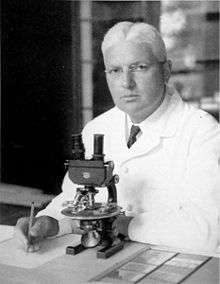Edgar Allen
Edgar Allen (May 2, 1892 – February 3, 1943) was an American anatomist and physiologist. He is known for the discovery of estrogen and his role in creating the field of endocrinology.[1]
Edgar Allen | |
|---|---|
 1933 | |
| Born | May 2, 1892 Canon City, Colorado |
| Died | February 3, 1943 (aged 50) |
| Nationality | |
| Alma mater | Brown University |
| Scientific career | |
| Fields | Anatomy, Physiology, Endocrinology |
| Institutions | University of Missouri, Washington University, Yale University |
Born on Cañon (Canyon) City, Colorado, Allen was educated at Brown University. After serving in World War I he took a position at Washington University in St. Louis until, in 1923, he was appointed to the chair of anatomy at the University of Missouri in Columbia, Missouri. Ten years later he was appointed to the chair at Yale University.
At Missouri, he began his studies of sex hormones. While it was commonly believed at the time that the female reproductive cycle was controlled by substance in the corpus luteum, Allen sought the answer in the follicles surrounding the ovum, leading to his discovery of estrogen, though it was identified six years later by Adolf Butenandt in 1929.
Allen died of a heart attack in 1943 while on duty with the United States Coast Guard.
References
- Cowan, Ruth (1970). "Allen, Edgar". Dictionary of Scientific Biography. 1. New York: Charles Scribner's Sons. pp. 123–124. ISBN 0-684-10114-9.
Further reading
- Gardner, W.U. (April 1943). "Edgar Allen (Obituary)." Science. Vol. 97, No. 2521, pp. 368–369.
- American National Biography, vol. 1, pp. 304–305.